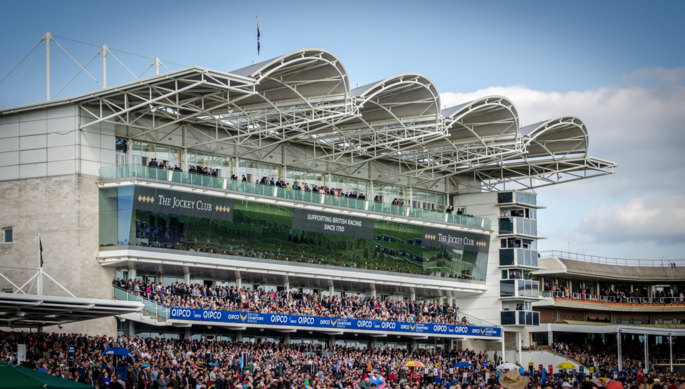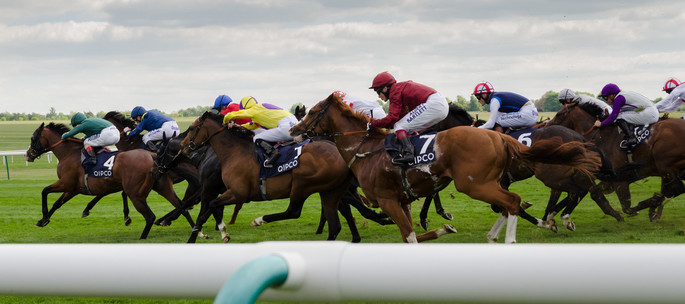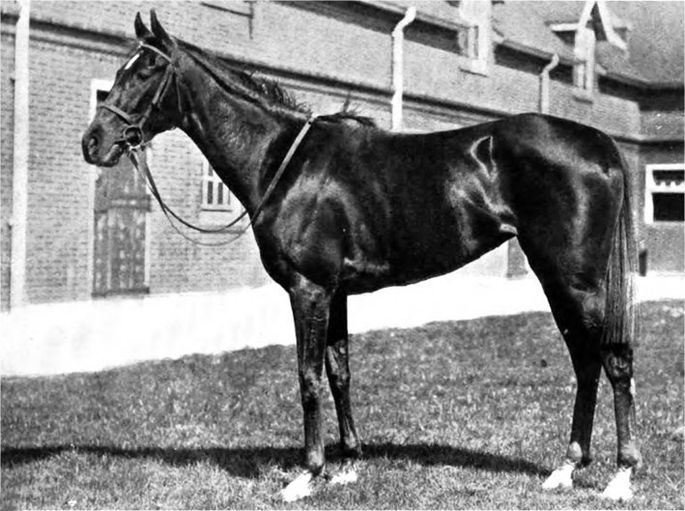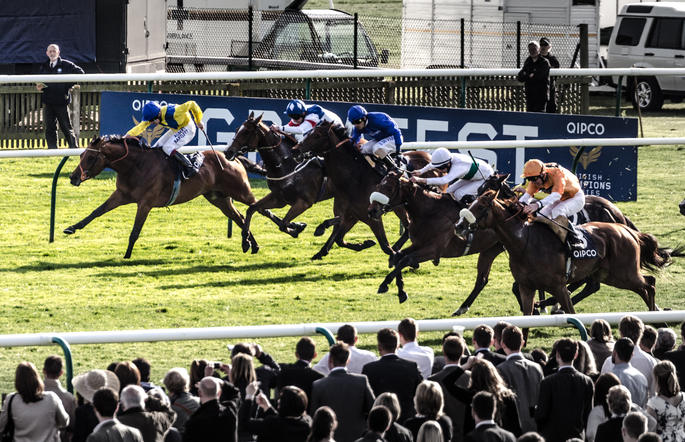Fast Facts
- When: 3rd, 4th & 5th May 2024
- Where: Rowley Mile Racecourse, Rowley Mile Drive, Newmarket CB8 0TF
- Watch: Major races live on ITV Racing
- Official Website: Newmarket Racecourse
The 1000 and 2000 Guineas are two of the most iconic flat races in the world and are the first of the five British Classics. Both are Group 1 races for three-year-old horses run over 1 mile at Newmarket’s Rowley Mile course.
Where they differ is that the 2000 Guineas is open to colts and fillies whereas the 1000 Guineas is restricted to fillies only. As a result you will generally find that the 2000 is the colts’ race, with the 1000 the fillies’ race.
The names of the races reflect the amount that could be won when they were first raced. One guinea equalled 1 pound and 1 shilling, about £1.05 in today’s money signifying just how lucrative they were back then, never mind currently. Today equality rules supreme with the same half a million pound purse available in both contests.
The Guineas Festival is one of Newmarket’s first big meetings of the season with the 2000 and 1000 Guineas the true stars of the show. The pair of British Classics have been injecting adrenaline into the veins of spectators at the ‘Home of Horseracing’ for over two centuries now and we’ll show all the best offers on the meeting below when available.
Existing Customer Free Bets & Money Back Offers
bet365 will be best price or joint best price on every horse for all races shown live on ITV Racing. Applies to bets placed on Win and Each-Way Fixed Odds markets from 10am on the day of the race. Prices matched against selected bookmakers.
Stats Articles
- Which Horses Have Won the Triple Crown of Flat Racing in the UK?
- Horses That Have Won Multiple British Classics: Has any Horse Ever Won All Five?
Event Stats
2000 Guineas Ante Post Favourites (2024)
| Horse | Trainer | Odds | Runs | Wins | Earnings |
|---|---|---|---|---|---|
| City Of Troy | Aidan O’Brien | 4/6 | 3 | 3 | £367k |
| Rosallion | Richard Hannon | 6/1 | 4 | 3 | £249k |
| Alyanaabi | Owen Burrows | 14/1 | 4 | 2 | £156k |
| Ancient Wisdom | Charlie Appleby | 14/1 | 5 | 4 | £177k |
| Henry Longfellow | Aidan O’Brien | 14/1 | 3 | 3 | £282k |
| Night Raider | Karl Burke | 16/1 | 2 | 2 | £10k |
| Sunway | David Menuisier | 16/1 | 4 | 2 | £159k |
| Task Force | Ralph Beckett | 16/1 | 3 | 2 | £90k |
| Ghostwriter | Clive Cox | 20/1 | 3 | 3 | £91k |
| Iberian | Charles Hills | 20/1 | 4 | 2 | £121k |
| River Tiber | Aidan O’Brien | 20/1 | 5 | 3 | £181k |
1000 Guineas Ante Post Favourites (2024)
| Horse | Trainer | Odds | Runs | Wins | Earnings |
|---|---|---|---|---|---|
| Ylang Ylang | Aidan O’Brien | 7/2 | 5 | 3 | £332k |
| Fallen Angel | Karl Burke | 4/1 | 4 | 3 | £257k |
| Dance Sequence | Charlie Appleby | 8/1 | 2 | 2 | £39k |
| One Look | Paddy Twomey | 10/1 | 2 | 2 | £551k |
| Opera Singer | Aidan O’Brien | 12/1 | 5 | 3 | £250k |
| See The Fire | Andrew Balding | 12/1 | 3 | 1 | £95k |
| Content | Aidan O’Brien | 14/1 | 7 | 2 | £97k |
| Matrika | Aidan O’Brien | 14/1 | 3 | 2 | £95k |
| Cinderella’s Dream | Charlie Appleby | 16/1 | 4 | 4 | £175k |
| Porta Fortuna | Donnacha O’Brien | 16/1 | 7 | 4 | £473k |
| Ramatuelle | Christopher Head | 16/1 | 5 | 3 | £200k |
Schedule
Friday 3rd May 2024 – Guineas Friday
- 1:15 – Newmarket Stakes (Listed) – 1m 2f
- 1:50 – bet365 Mile (Group 2) – 1m
- 2:25 – King Charles II Stakes (Listed) – 7f
- 3:00 – Nyetimber Open Handicap (Class 2) – 7f
- 3:35 – Jockey Club Stakes (Group 2) – 1m 4f
- 4:10 – British EBF Maiden Fillies’ Stakes (Class 2) – 5f
- 4:45 – Nyetimber Fillies’ Maiden Stakes (Class 3) – 1m 2f
- 5:20 – Race Horse Lotto Handicap (Class 3) – 1m
Saturday 4th May 2024 – 2000 Guineas Day
- 1:40 – Howden Handicap Stakes (Class 2) – 1m 4f
- 2:15 – Howden Ellen Chaloner Stakes (Listed) – 6f
- 2:50 – Howden Heritage Handicap (Class 2) – 6f
- 3:25 – Howden Suffolk Stakes (Class 2) – 1m 1f
- 4:00 – Howden Palace House Stakes (Group 3) – 5f
- 4:40 – QIPCO 2000 Guineas Stakes (Group 1) – 1m
- 5:15 – Howden Insurance Handicap (Class 2) – 6f
- 5:50 – Howden Bloodstock Handicap (Class 4) – 7f
Sunday 5th May 2024 – 1000 Guineas Day
- 1:15 – bet365 Gordon Richards Stakes (Group 3) – 1m 2f
- 1:50 – Howden Heritage Handicap (Class 2) – 1m 6f
- 2:25 – Howden Pretty Polly Stakes (Listed) – 1m 2f
- 3:00 – Howden Dahlia Stakes (Group 2) – 1m 1f
- 3:40 – QIPCO 1000 Guineas Stakes (Group 1) – 1m
- 4:15 – Howden British EBF Maiden Stakes (Class 3) – 5f
- 4:50 – Howden Handicap (Class 3) – 1m
- 5:25 – Howden Bloodstock Handicap (Class 3) – 1m 2f
All race times and titles are subject to change.
About The 2000 & 1000 Guineas

Both the 2000 Guineas and the 1000 Guineas are two of British horse racings ‘Classics’. There are five of them in total and they take place every year during the flat racing season. If you’re wondering, the Epsom Oaks and the Epsom Derby along with the St. Leger Stakes make up the other three. They are all restricted to three-year-olds and are considered by many to be the pinnacle of flat racing, mainly because it shows how well adept a horse is at handling a race against competitors in its own age range.
The races are pretty simple in that it’s a 1 mile contest over turf. Horses have often qualified for the race by winning or at least having good shows in feeder events such as the Nell Gwyn Stakes and Fred Darling Stakes for the 1000 Guineas, and the Craven Stakes and Greenham Stakes for the 2000 Guineas.
The prize fund for 2023 was set at £500,000 for both races. It is worth noting that prize money has already jumped from £350,000 in 2012 to their current level in 2016, an increase of £150,000 in just four years, highlighting both race’s importance.
No horse has won all five classics due to the fact that the Oaks and 1000 Guineas are restricted to fillies and the two Epsom and Newmarket races are run just a day apart from each other. One achievable feat is winning the Triple Crown or Fillies Triple Crown. This is where the two Guineas make up one leg, the Epsom races another and the St. Leger Stakes being the third. This remains a near impossible task with the three races in each triple crown run at very different distances. As a result, we may not see another triple crown winner.
About the 2000 Guineas

The 2000 Guineas was first raced five years before the 1000, in 1809. The race was open to three -year-old thoroughbred colts and fillies. The original races were set up by the Jockey Club, with Sir Charles Banbury leading the charge. It’s worth noting that Banbury had also founded The Derby, run at Epsom racecourse and another of the Classics, so by the time he introduced this one he was already held in high esteem within the racing community.
Perhaps somewhat unsurprisingly, the race was named after the prize fund available to the participants, with a guinea being worth twenty-one shillings or £1.05. Though it wasn’t initially loved by all in the racing community, it soon began to grasp the imagination and by the middle of the 1860s it was considered to be one of the most prestigious events in flat racing, particularly within that three-year-old age bracket.
In fact, such is the extent to which the race format is so well regarded, there are numerous versions of the 2,000 Guineas held around the world.
Worldwide Versions of the 2000 Guineas
| Country | Race | Venue | First Run |
|---|---|---|---|
| Britain | 2000 Guineas | Newmarket | 1809 |
| France | Poule d’Essai des Poulains | Longchamp, Paris | 1840 |
| Italy | Premio Parioli | Capannelle, Rome | 1907 |
| Germany | Mehl-Mülhens-Rennen | Weidenpesch, Cologne | 1871 |
| Ireland | Irish 2,000 Guineas | Curragh, Newbridge | 1921 |
| Japan | Satsuki Shō | Nakayama, Funabashi, Chiba | 1939 |
| Australia | Australian Guineas | Flemington, Melbourne | 1986 |
The 2000 Guineas has trial races like the Craven Stakes and the Greenham Stakes, but most horses go into it having not raced anywhere else that season. That can make for an extraordinarily exciting race, with the participants opening their legs for the run for the first time in months on a competitive stage. It’s been known for horses that have done well in the 2000 Guineas to go on and win the Derby, as demonstrated by Camelot in 2012.
As mentioned previously. the race is part of the Triple Crown, which includes the Derby and the St Leger. No horse since Nijinsky in 1970 has been able to win the Triple Crown, highlighting just how tough and impressive a feat it is.
Interesting 2000 Guineas Facts

The 2000 Guineas has seen some of the best horses to have ever lived win the race, including the likes of Frankel, Sea The Stars, King Of Kings, Nijinsky and many, many more. The fastest time ever recorded in the race was 1 minute 34.72 seconds recorded by Kameko in 2020, though this race was run in June so quicker ground may have been a factor. Previously the record was the 1 minute 35.08 seconds by Mister Baileys in 1994. Since 1900, the widest winning margin achieved by a horse was the eight lengths that Tudor Minstrel managed in 1947.
Punters will no doubt be interested to know the winning horse which has had the biggest start price. That honour goes to Rockavon, winning as a 66/1 outsider back in 1961. That was the only race of note that the horse won and though he went on to sire a number of minor winners, none of his sires outperformed him. Certainly bettors would’ve been happier to win their wager on him than on the shortest odds horse to win, with St Frusquin coming in at 12/100 in 1896.
The number of horses participating in the race has varied wildly over the years. In both 1829 and 1830, for example, just two horses ran. On hundred years later in 1930, on the other hand, the record for the most horses to compete was set when twenty-eight horses ran.
In terms of personal records, Jem Robinson is the 2000 Guineas Stakes most successful jockey thanks to his nine wins, dating from 1825 to 1848. Obviously, no horse has won it more than once on account of the fact that it’s only open to three-year-olds, but Aidan O’Brien certainly knows how to get the most out of them judging by his ten wins as a trainer. All of those wins came with horses owned in some part by Sue Magnier and she also had Entrepreneur who won in 1997, meaning that she’s the most successful owner in the race with eleven wins.
About the 1000 Guineas

The 1000 Guineas came about some five years after the inaugural 2000 Guineas and was specifically targeted at fillies, again aged three years. The reduced prize money on offer that gives the race its name meant for many years that it wasn’t as prestigious as the 2000. That soon changed however, and today the two races are widely regarded as top class contests in their own right. To highlight this fact further, in 2001 it was decided that both the 1000 and 2000 Guineas would have the same prize money though in 2021, the 1000 Guineas was worth slightly less with a £375k prize fund versus the £400k of the 2000 Guineas.
Part of the reason for this is that the races are practically identical, with both being run on Newmarket’s Rowley Mile over a distance of exactly one mile. The big difference between the two races is the sex of the horses participating in them, with the 1000 open exclusively to fillies and the 2000 for any horse other than geldings. Even the weight of nine stone is the same, though fillies get a three pound allowance when running in the 2000 Guineas.
The 1000 Guineas is also a part of its own Triple Crown, but this one is reserved for just races that include fillies. The other races are that of the Epsom Oaks and St Leger. Many people still consider the 1000 as a feeder race for the Epsom Oaks, such is the esteem in which the latter is held. The last horse that was able to win both the 1000 Guineas and the Oaks was Love in 2020. Such is the difficulty of the feat, it’s rare for horses to even attempt to win the Fillies Triple Crown.
As with the 2000 Guineas, the Group 1 race was the brainchild of Sir Charles Bunbury and came under the jurisdiction of the Jockey Club. The fact that the 1000 Guineas Stakes was restricted to fillies meant that it didn’t take long for it to become one of the most important events for them in the horse racing calendar. Nowadays it is served by trial races in the form of both the Nell Gwyn Stakes and the Fred Darling Stakes.
Much like with its 2000 Guineas alternative, this is often the first race of the entire season for some of the competitors that take part in it. It is also a race which is replicated across the globe.
Worldwide Versions of the 1000 Guineas
| Country | Race | Venue | First Run |
|---|---|---|---|
| Britain | 1000 Guineas | Newmarket | 1814 |
| France | Poule d’Essai des Pouliches | Longchamp, Paris | 1883 |
| Italy | Premio Regina Elena | Capannelle, Rome | 1907 |
| Germany | German 1,000 Guineas | Düsseldorf | 1919 |
| Ireland | Irish 1,000 Guineas | Curragh, Newbridge | 1922 |
| Japan | Oka Sho | Hanshin, Takarazuka, Hyogo | 1939 |
| Australia | Thousand Guineas | Caulfield, Melbourne | 1946 |
| New Zealand | New Zealand 1000 Guineas | Riccarton Park, Christchurch | 1973 |
Interesting 1000 Guineas Facts

The 1000 Guineas has seen just as an impressive array as winners as its older brother, with the likes of Blue Bunting, Cape Verdi, Homecoming Queen and Russian Rhythm being victorious, to name just a few. The fastest time recorded in the race was in 2009, with Ghanaati winning in just 1 minute and 34.22 seconds, half a second faster than the quickest 2000 Guineas time.
The race’s most successful jockey to date is George Forham, who won seven times between 1859 and 1883. The leading owner is the 4th Duke of Grafton who had eight different winners between 1819 and 1827. They were all trained by Robert Robson who was also responsible for the 1818 win of Corinne, making him the most successful trainer in the race’s history.
George Fordham is not only the race’s most successful jockey but also the person who set the record for the widest winning margin. He raced home twenty lengths clear on the back of Mayonaise in 1859. Interestingly, the longest odds winner romped home with the same odds as the longest odds winner of the 2000 Guineas at 66/1. That was Billesdon Brook in 2018, pleasing her backers a lot more than the 1/10 that Crucifix returned in 1840.
As with the 2000 Guineas, it has seen participant numbers fluctuate over the years. The fewest competitors to take part in the 1000 Guineas is just one, with Tontine enjoying a walkover in 1825. In comparison, the most horses to join the race were the twenty-nine who did so in 1926.
